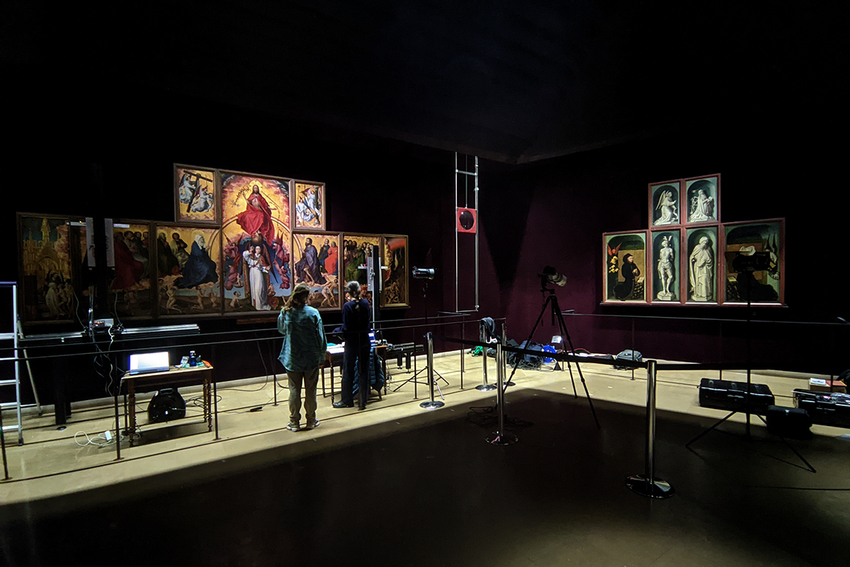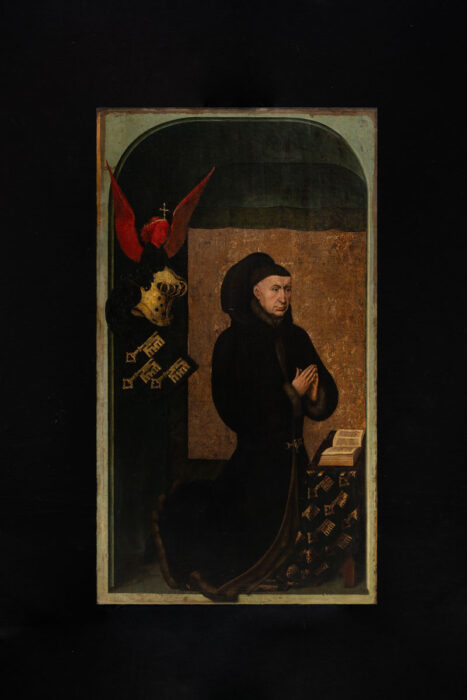
Marina Luchetti and Carolina Gris operating the Lucida 3D Scanner to record the 3D surface © Gabriel Scarpa for Factum Foundation
The work underwent a major restoration from 1875 to 1878 during which the restorers split, by sawing in their thickness, the six panels painted on both sides, in order to present the altarpiece in its two configurations: open on the continuous scene of the Last Judgment, which unfolds over nine panels; and closed, showing the portraits of the founders, Nicolas Rolin and Guigone de Salins, in prayer before Saint Sebastian and Saint Anthony, and surmounted by an Annunciation painted on six panels. For this reason, the altarpiece is presented today in two parts whereas, before this restoration, they formed one single work.
The state of conservation of the altarpiece is regularly checked by conservators-restorers specialising in painting and wooden supports, which require preventive conservation interventions to guarantee the polyptych’s integrity.
The high-resolution colour and 3D surface data scanned by Factum Foundation allows the monitoring of the state of conservation of the altarpiece with a great degree of precision, unmatched to date. The scanned data constitutes a precious documentary fund for the history of this work.
The digital information relating to the artwork, both raw and processed files was provided to the Hospices Civils de Beaune, who will own all rights related to the data for all current and future applications.

All the painted panels were recorded in both 3D and colour © Gabriel Scarpa for Factum Foundation
The Weight of a Soul. Which is lighter: the soul or a feather?
A Tribute Project to Bruno Latour (1947 – 2022)

Left: Archangel Michael as he appears on the Beaune Altarpiece by Rogier Van Der Weyden Right: Archangel Michael, Erhart Küng (and master masons), 1485 Historical Museum, Bern. The praying blessed soul is heavier than the ferocious devil being slain by Michael
As ideas emerge we will share some of them. Simon Schaffer drew attention to a change that links Factum’s work in Egypt to the central figure of the Archangel Michael. In Pharaonic texts it is Maat who weighs the soul of the dead against her ostrich feather representing truth. If the soul of the dead is heavier than the feather, they are doomed to oblivion. If it is lighter, they are blessed and their end is a new beginning.
The 3D scan of the surface of the central panel of the Beaune Altarpiece shows traces of a significant change. In the final version, the blessed souls are lighter than the damned. But it appears that originally they were heavier and the scales were positioned with the good souls outweighing the damned.
The x-ray (plate CXCVI) published in “L’Hôtel-Dieu de Beaune” written by Nicole Veronee-Verhaegen for the series ‘Les Primitifs Flamands’ clearly confirms the scales were originally lower on the left and higher on the right (as you look at the altarpiece from the front). At the time, in many works of art, weight was associated with goodness while the damned souls literally lacked gravitas. Research is now ongoing into why and when Rogier Van der Weyden made this change. Part of the focus will also look at why Michael is weighing souls in the first place.
By chance, for the exhibition ‘In Ictu Oculi’ at the Spanish Gallery in Bishop Auckland, Factum made a facsimile of a painting by Juan de Valdés Leal, Finis Gloriae Mundi, in which the hand of Michael holds a perfectly balanced scale with the Seven Deadly Sins on one side and the Seven Works of Mercy on the other. According to an entry in the records of the Hermandad de la Santa Caridad (28 December, 1672) the two vanitas paintings by Valdés Leal were known as Jeroglificos de las Postrimerias – Hieroglyphs for the Afterlife. Deciphering the meaning of these ‘hieroglyphs’ will take more time and reflection.
Facsimile of Panel 10
As part of the exhibition ‘REVISITING VAN EYCK. The Virgin of Chancellor Rolin’ at the Musée du Louvre (March 20 – June 17, 2024), the Hospices Civils de Beaune used high-resolution data from the Beaune Altarpiece to create a facsimile of one of the exterior panels (known as Panel 10). While the original panel, depicting Nicolas Rolin, chancellor of the Duchy of Burgundy and founder of the Hôtel-Dieu de Beaune, is part of the exhibition at the Louvre, the Factum Foundation has created a facsimile that is exhibited in Beaune in the absence of the original.
The analysis of the high-resolution digital data allowed for a more detailed study of the damaged and restored parts of the panel, especially on the surface under the gold leaf. During the facsimile creation process, the Factum Foundation team collaborated with art historians and restorers from the Hospices Civils de Beaune, who received a panel covered with a surface texture identical to the original for conservation and mediation purposes.
The book The Flemish Primitives. The Hôtel-Dieu de Beaune. The polyptych of the Last Judgment by Nicole Veronee-Verhaegen (1973) was fundamental for the team, offering an in-depth examination of the panel’s history, its complex construction, and the extensive restoration and conservation work carried out on the panel since its creation.
The high-resolution data was 3D printed using raised printing and moulded in gesso before printing colour onto the surface using Factum’s custom flatbed printer. The facsimile and surface texture were both mounted on a wooden support panel. Gold leaf and gold powder were used to achieve gilding before varnishing.

The finished facsimile panel © Oak Taylor-Smith | Factum Foundation

Detail of Panel 10 showing the discreet gilding marks © Oak Taylor-Smith | Factum Foundation










